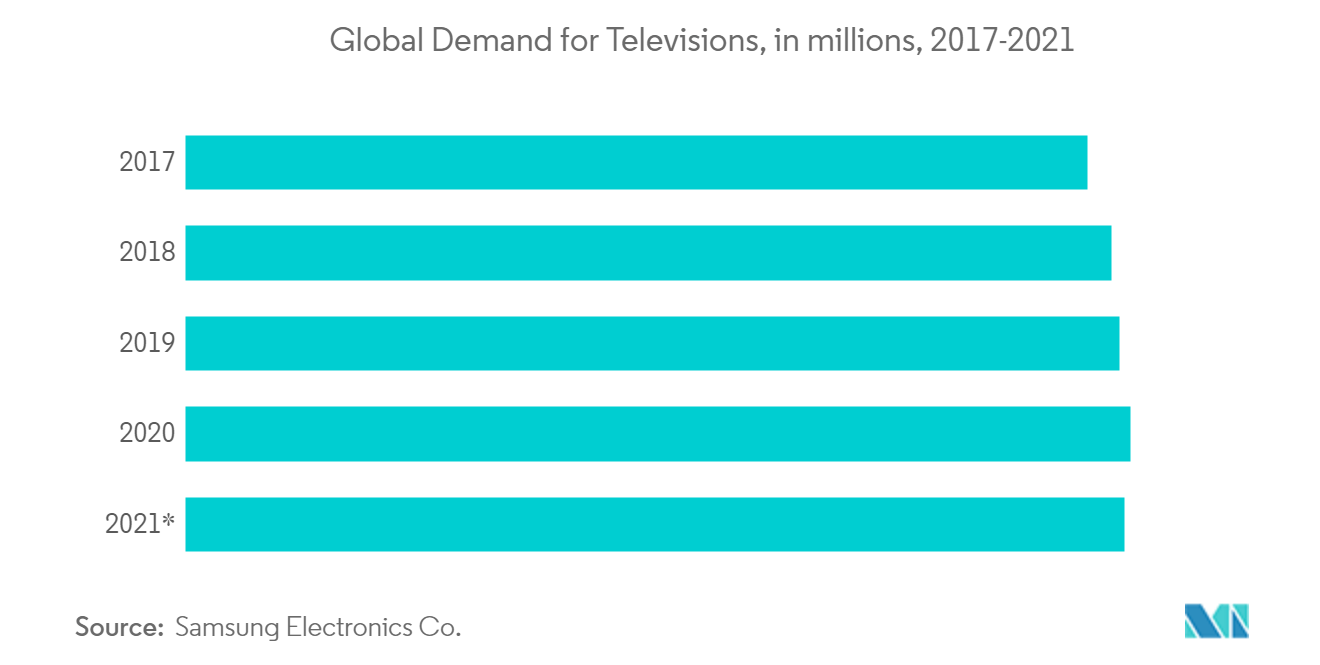Market Trends of Smart TV Industry
This section covers the major market trends shaping the Smart TV Market according to our research experts:
QLED is Expected to Witness Significant Growth
- QLED stands for quantum light-emitting diode. QLED panels work the same way as LED TVs. There is a backlight built from hundreds or thousands of LEDs that light the individual pixels. QLED improves on standard LED by employing nanoparticles (quantum dots) to supercharge the brightness and color of these individual pixels. The result is a more vibrant color. QLED Alliance consists of Samsung, Hisense, and TCL, devoted to furthering the Quantum Dot cause, which is aiding in the market's growth and new product development. The market is mainly growing due to vendor releases noticed in the past year. QLED panel is expected to retain the highest market share due to increased adoption, as it comprises various features that other panel types are unable to offer.
- For instance, although both OLED and QLED are costly, some of the cheapest OLEDs cost around USD 1,800, while the starting price of some QLEDs is USD 1,000. Moreover, 55 inches is the smallest screen size for OLEDs, while QLEDs can be much lower. QLED's innovations, deeper blacks, better colors, and wider viewing angles tackle three traditional LED and LCD technology problems, further driving the market demand. Samsung is the only manufacturer without an OLED set as it believes that its QLED technology is just as capable, giving the best quality picture. It was the first vendor to debut the QLED panel. Other vendors, such as LG, Panasonic, and Sony, have chosen OLED displays for their high-end sets.
- However, QLEDs cannot produce precisely the same level of inky blacks as pricier OLED TVs because OLED panels do not use a uniform backlight. Instead, each pixel is an LED that can be switched on and off to create colors or total darkness. By switching the LEDs off completely, OLED avoids the light pollution from the backlight that makes things look a little grey on LED TVs.
- The QLED display is gaining traction with leading smart TV manufacturers unveiling new products using the same technology, which is expected to drive the segment's growth during the forecast period. For instance, Samsung announced the launch of a new series of QLED Smart TVs, the QT67 range, in its domestic market (South Korea). These are the first QLEDs from Samsung to achieve a first-class energy efficiency rating. Similarly, in April 2021, Xiaomi launched a new Android-powered smart TV, the Mi QLED TV 75, in India. The smart TV model sports a 75-inch display that supports Ultra-HD (4K) resolution and a 120Hz refresh rate, which is the company's largest TV model to date.
- In December 2021, Samsung Electronics Co. Ltd announced the latest development in its ongoing partnership with the streaming giant, Netflix, to herald the release of the second season of its hit show, Emily in Paris, produced by MTV Entertainment Studios. Samsung's latest line of premium products is set to push the boundaries of innovation, showcasing the brands' ability to combine style with flagship innovation and craftmanship. Some of the Samsung products include The Serif TVs and The Sero TVs.

Asia-Pacific is Expected to Witness Significant Growth
- Asia-Pacific is the dominating market for smart TVs. It is expected to continue its dominance over the forecast period, owing to the growing demand for smart TVs by end-users and the emerging economies of India, China, and Japan. The increasing net disposable income of consumers has been a significant factor for continued demand in the region. The growth is also attributed to the rising popularity of OTT VOD platforms, such as Amazon Prime Video, Netflix, and HOOQ, across the region. The availability of supporting content for these devices, such as HD videos, HD set-top boxes, and games, has further acted as a catalyst in demand generation.
- The presence of the Chinese players has been critical in the competitive pricing of products in these markets, many of which have entered partnerships with e-commerce platforms to offer their products. Third-party service providers have helped ensure that consumers opt for these products, indirectly helping the market. In Asia-Pacific, India is the most attractive market for vendors. In January 2022, Samsung Electronics Co. Ltd unveiled its newest MICRO LED, Neo QLED, and Lifestyle TVs ahead of CES 2022. With advancements in the picture and sound quality, more screen size options, customizable accessories, and an upgraded interface, the 2022 screens bring the vision of ‘Screens Everywhere, Screens for All’ closer to reality with life-like images, immersive sound, and hyper-personalized experiences.
- In December 2021, Samsung Electronics Co. Ltd announced that select 2022 4K and 8K TVs and gaming monitors would support the new HDR10+ GAMING standard, delivering an immersive, ultra-responsive HDR gaming experience to gamers. This new standard, developed by HDR10+ Technologies LLC, gives game developers the tools they need to provide gamers with a compelling and consistent HDR gaming experience without manual calibration across various display technologies for different input sources, including consoles and PCs.
- India has a large installed base of CRT and non-smart TVs, which can be upgraded and have attracted the attention of major smart TV manufacturers focusing on offering products that suits the requirements of the Indian customers.
- The companies with relatively smaller market presence are focusing on the e-commerce platform to launch their products in the market. For instance, in 2021, Tata Group-owned electronics store chain Croma entered a partnership with Amazon to launch a new range of smart TVs with built-in fire devices for customers in India. The product is expected to have all streaming content from over 5,000 apps, including Amazon Prime Video, Netflix, YouTube, Disney + Hotstar, Zee5, and SonyLiv.


